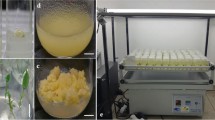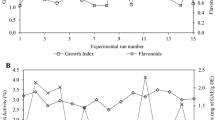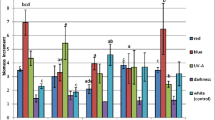Abstract
The effects of the concentration of PO4 3-, NO3 −, Fe 2+, sucrose and inoculum size on the accumulation of blue pigment and growth of suspension cultures of Lavandula spica D.C. (\( \equiv \) L. latifolia Vill.), were studied. The combination of 2.5 mM PO4 3-, 14.1 mM NO3 −, 1 mM Fe 2+, 30 g l−1 sucrose and 10 g l−1fresh weight of inoculum, promoted a 7-fold enhancement on the productivity of blue pigment in comparison to the control medium. Among all the culture medium constituents tested, phosphate exerted the highest beneficial effect and Fe2+ showed to be essential for the accumulation of the pigment. High levels of sucrose (60 or 90 g l−1) did not stimulate the accumulation of blue pigment. In these conditions, cell growth and cell viability were drastically affected.
Similar content being viewed by others
References
Banthorpe DV, Bilyard HJ & Watson DG (1985) Pigment formation by callus of Lavandula angustifolia. Phytochemistry 24(11): 2677-2680
Boelens MH (1986) The essential oil of spike lavender Lavandula latifolia Vill. (L. spica D.C.). Perfumer and Flavorist. 11: 43-63
Contin A, Van der Heijden R, Ten Hoopen HJG & Verpoorte R (1998) The inoculum size triggers tryptamine or secologanin biosynthesis in a Catharanthus roseus cell culture. Plant Sci. 139: 205-211
De-Eknamkul W & Ellis BE (1985) Effect of macronutrients on growth and rosmarinic acid formation in cell suspension cultures of Anchusa officinalis. Plant Cell Rep. 4: 46-49
Dörnenburg H & Knorr D (1997) Challenges and opportunities for metabolite production from plant cell and tissue cultures. Food Technol. 51(11): 47-54
Ilieva M & Pavlov A (1996) Rosmarinic acid by Lavandula vera cell suspensions: phosphorous effect. Biotechnol. Lett. 18(8): 913-916
King PJ & Street HE (1977) Growth patterns in cell cultures. In: Street HE (ed) Plant Tissue and Cell Culture (pp 307-387). Blackball Sci. Pupb., Oxford
Murashige ST & Skoog F (1962) A revised medium for rapid growth and bioassays with tobacco tissue culture. Physiol. Plant. 15: 473-497
Nakajima H, S onomoto K, Usui N, Sato F, Ichimura K, Yamada Y, Tanaka A & Fukui S (1985) Entrapment of Lavandula vera cells and production of pigments by entrapped cells. J. Biotechnol. 2: 107-117
Nakajima H, Sonomoto K, Sato F, Ichimura K, Yamada Y & Tanaka A (1989) Enhancement of pigment productivity of immobilized cultures Lavandula vera cells by limitation of nitrogen sources. J. Ferm. Bioeng. 67: 306-308
Nakajima H, Sonomoto K, Sato F, Yamada Y & Tanaka A (1990) Pigment synthesis by immobilized cultured cells of Lavandula vera and characterization of a component of the pigments. Agric. Biol. Chem. 54(1): 53-59
Rudge K & Morris P (1986) The effects of osmotic stress on growth an alkaloid accumulation of Catharanthus roseus. In: Morris PAH, Scragg A, Stafford M & Fowler W (eds) Secondary Metabolism in Plant Cell Cultures (pp 75-81). Cambridge University Press
Sakurai M, Mori T, Seki M & Furusaki S (1996) Changes of anthocyanin composition by conditioned medium and cell inoculum size using strawberry suspension cultures. Biotechnol. Lett. 18: 1149-1154
Trejo G (1997) Efecto de las condiciones de cultivo sobre la acumulación de pigmento azul en cultivo de células en suspensión y de células inmovilizadas de Lavandula spica. M. Sc. Thesis. CINVESTAV-IPN. Mexico. (In Spanish)
Trejo-Tapia G, Jimenez-Aparicio A, Rodriguez M, Sepulveda G, Salcedo G, Martinez B, Gutierrez G & De Jesús A (1999) Influence of medium constituents on growth and betalain production in cell suspension cultures of Beta vulgaris. Asia-Pacific J. Mol. Biol. Biotechnol. 7(2): 167-172
Trejo-Tapia G, Jiménez-Aparicio A, Rodríguez-Monroy M, De Jesús-Sánchez A & Gutiérrez-López G (2001) Influence of cobalt and other microelements on the production of betalains and the growth of suspension cultures of Beta vulgaris L. Plant Cell Tiss. Org. Cult. 67: 19-23
Wang HQ, Zhong JJ & Yu JT (1997) Enhanced production of taxol in suspension cultures of Taxus chinensis by controlling inoculum size. Biotechnol. Lett. 19: 353-355
Watanabe K, Sato F, Furuta M & Yamada Y (1985) Induction of pigment production by S-containing compounds in cultured Lavandula vera cells. Agric. Biol. Chem. 49: 533-534
Webb JK, Banthorpe DV & Watson DG (1984) Monoterpene synthesis in shoots regenerated from callus cultures. Phytochemistry 23: 903-904
Widholm JM (1972) The use of fluorescein diacetate and phenosafranine for determining viability of cultured plant cells. Stain Technol. 47: 189-194
Author information
Authors and Affiliations
Corresponding author
Rights and permissions
About this article
Cite this article
Trejo-Tapia, G., Arias-Castro, C. & Rodríguez-Mendiola, M. Influence of the culture medium constituents and inoculum size on the accumulation of blue pigment and cell growth of Lavandula spica . Plant Cell, Tissue and Organ Culture 72, 7–12 (2003). https://doi.org/10.1023/A:1021270907918
Issue Date:
DOI: https://doi.org/10.1023/A:1021270907918




